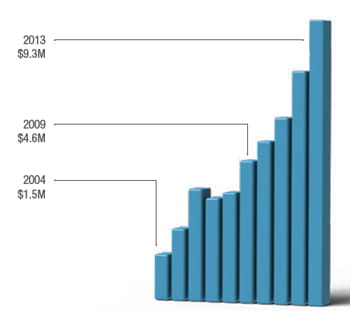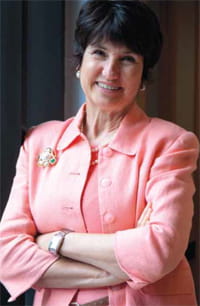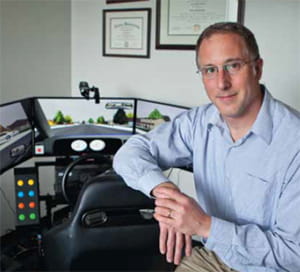Changing Behaviors

Growing recognition of the impact of behavior on health brings unprecedented expansion to the Division of Behavioral Medicine and Clinical Psychology
On any given day at Cincinnati Children’s, you can find teens in a laboratory using a driving simulator to measure the effects of shortened sleep on their reflexes and concentration. In another, children connected to biofeedback devices practice how to manage chronic pain. Meanwhile, hundreds of miles away, a boy with Crohn’s disease receives a text alert reminding him to take his next dose of medication.
 |
Research support at the Division of Behavioral Medicine has soared to more than $9.3 million in direct funds in 2013. |
These kids are taking part in just a few of the many research projects happening in the Division of Behavioral Medicine and Clinical Psychology (BMCP) at Cincinnati Children’s — one of the largest groups of its kind in the US.
The division’s faculty has grown to more than 70 members in the past 15 years. Its investigators received more than $12 million in the past year in external grant funding — the second highest total of any of the medical center’s 56 research divisions.
“There is no place like Cincinnati Children’s in terms of the appreciation for what psychology can bring to the research enterprise or to patient care,” says Lori Stark, PhD, Director of BMCP since 1998.
Research within BMCP focuses on the interactions between child health, behavior, biology, family and community. The division includes nationally recognized research centers for ADHD, childhood obesity and treatment adherence.
 |
Dr. Lori Stark leads a growing division that includes nationally recognized research centers for ADHD, childhood obesity and treatment adherence. |
Other important research programs include nutrition and eating, sleep problems, pain disorders, childhood abuse, migraine headaches, cystic fibrosis, sickle cell disease, and the neuropsychology of brain tumors and traumatic brain injuries. Meanwhile, clinical psychologists provide expert assessment and treatment services and work with children facing anxiety, sadness, difficulties with parent-child interactions, or peer relationship problems.
BUILDING UPON STRENGTHS
The BCMP was one of five divisions that recently underwent a Scientific Advisory Committee review at Cincinnati Children’s. The external reviewers, who included two past presidents of the Society of pediatric Psychology, said they have seen no other behavioral medicine programs like this in the US.
“Very few hospitals have assembled their psychologists all in one division,” Stark says. “That’s particularly attractive for recruiting strong researchers. They know if they come here they will receive comprehensive support for their work, plus the opportunity to collaborate with others in their own discipline as well as with world-class researchers in many other fields.”
Our team approach includes:
- Collaborations with 18 specialized programs at Cincinnati Children’s from international adoptions to liver transplantation to epilepsy.
- Access to quantitative psychologists at the BMCP Data Core, who are experts at designing studies and developing mathematical models to measure psychological processes.
- Senior-level peer review of all grant applications, which gives division projects better odds of securing funding.
- One of the largest postdoctoral fellowship programs in the US, which admits seven to eight new pediatric psychology fellows each year.
COLLABORATIONS EXPAND
In one of its largest collaborations to date, the BMCP is working with the Cancer and Blood Diseases Institute to launch a program to support more children with cancer as they face treatment adherence problems and other coping issues. Ahna Pai, PhD, directs the program, which is expected to grow to include nine clinicians and three research faculty.
In epilepsy-related research, Avani Modi, PhD, Co-Director of the New Onset Seizure Clinic at Cincinnati Children’s is working with Tracy Glauser, MD, and others to improve treatment adherence. This project involves supplying patients with pill bottles fitted with electronic caps that monitor how often and when the bottles were opened. Clinicians can use the data to zero in on why a particular patient is missing his medication doses.
 |
Dr. Dean Beebe uses a driving simulator to test how lack of sleep affects teenage driving. |
Dean Beebe, PhD, Director of our Neuropsychology Program, uses a driving simulator to study the risks of sleep deprivation on the driving behaviors of teens. In ADHD research, Jeff Epstein, PhD, Director of our Center for ADHD, plans to use the driving simulator paired with an eye tracking device to improve the driving skills of teens with ADHD by reducing distractibility. Epstein also led development of a web portal that allows pediatricians to collect and interpret parent and teacher ADHD rating scales, communicate with parents and teachers about patients, track patient outcomes and more.
Susmita Kashikar-Zuck, PhD, leads a team of investigators in sports medicine, BMCP and rheumatology in developing a neuromuscular training program to increase functioning and reduce pain for teens with fibromyalgia.
Our faculty members also play an important role in cystic fibrosis(CF)-related research. Scott Powers, PhD, Director, Center for Child Behavior and Nutrition Research and Training, leads a project to encourage children with CF to eat, even when they do not want to. Research has shown that children with CF have better lung function if they can stay close to the 50th percentile of body mass index.
Kevin Hommel, PhD, is leading and participating in more than a dozen adherence-related studies, including innovative work that uses social media and telehealth approaches to help children with inflammatory bowel disease (IBD) stick to their treatment regimens.
MANAGING GROWTH
The wide range of projects within BMCP reveals the interconnected role child psychology plays in understanding and treating many types of diseases and conditions. However, SAC reviewers and senior leaders agree the division faces some challenges, most of which are byproducts of its size and growth.
As accomplished faculty members land research funding and gain prominence, they also become more attractive to other research centers. Stark and other senior leaders are working on ways to enhance retention to prevent potential disruptions to ongoing research.
Meanwhile, as concern about the future of government grant funding continues, leaders are studying how to provide gap funding to continue strategic projects should research budget cuts occur.
“Longer term projects can be affected by dry spells and shifts in funding priorities,” Stark says. “One of our goals is to develop ways to support our most productive investigators in these situations.”
Stark predicts the role that behavioral health plays in maintaining and improving children’s overall health will not waver.
“Our growth reflects a long-term commitment from senior leadership who had the foresight to see behavioral health as being independent from and equal to other specialties,” she says.
OUR TEAM APPROACH INCLUDES
Collaboration
Collaborations with 18 specialized programs at Cincinnati Children’s from international adoptions to liver transplantation to epilepsy.
Access
Access to quantitative psychologists at our Data Core, who are experts at designing studies and developing mathematical models to measure psychological processes.
Peer Review
Senior-level peer review of all grant applications, which gives division projects better odds of securing funding.
Training
One of the largest postdoctoral fellowship training programs in the US, which admits seven to eight new pediatric psychology fellows each year.



